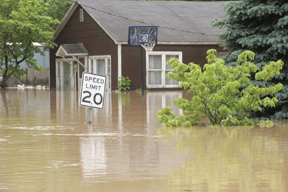ISO Emerging Issues Perspective
Educate yourself to provide the best coverages for your clients
Flood insurance in the United States has a long and complicated history, dating back to 1968, when the National Flood Insurance Program (NFIP) was created with the noble intention of providing affordable insurance for flood-prone communities throughout the country.
As of today, the program is more than $23 billion in debt, primarily because of large payouts from Hurricane Katrina and Superstorm Sandy. Claims costs continue to rise, flooding frequency and severity are increasing, and premium levels do not seem adequate to deliver even a slim underwriting profit or help the program break even.
With the NFIP up for reauthorization this year (September 30, 2017), Congress and many insurers are hoping to see the program reformed and the flood insurance market revitalized. With the possibility of revitalization in reach, insurers, brokers, and agents would be well advised to educate customers and themselves about the risks of flooding and the coverages available. Preliminarily, here are four myths that should be addressed:
Myth #1: Home owners who purchase flood policies from the NFIP have all the coverages they need in the event of a flood.
That’s often not the case. NFIP offers coverage for both buildings and personal property, but many limitations could be important for home owners to know about. First, the coverage limits are $250,000 for a one- to four-family structure and $100,000 for the contents of a one- to four-family residence. That may not be enough to cover all the damage to a dwelling and personal possessions.
Coverage limitations are another concern. In basements, for instance, NFIP covers the replacement of items needed to support the structure, such as a boiler or circuit breaker. If the insured purchased contents coverage, NFIP also would cover a washer/dryer and air conditioner. But NFIP offers no coverage for basement improvements, including floors, ceilings, and walls, which are important to many home owners when rebuilding after a flood.
NFIP also doesn’t cover loss of use or additional living expenses incurred because of flooding. If an insured needs to rent an apartment or stay in a hotel until the home is repaired, that cost would not be covered.
Myth #2: You don’t need to worry about flood insurance unless you live in a 100-year or 500-year flood zone.
That’s not true, especially in light of recent events. Some may posit that people who live in those flood zones would be the only ones with any significant risk. In fact, properties in a 100-year flood zone have a 1% chance of flooding every year. Those in a 500-year flood zone have a 0.2% chance of flooding every year.
The recent September 2016 flooding in Iowa, the August 2016 flooding in Louisiana, and the October 2015 flooding in South Carolina demonstrated that any area can be affected by flood that results from environmental and atmospheric changes. Many flood hazard maps have become outdated because of urban growth and changing coastlines. The Federal Emergency Management Agency is currently updating the maps, but it can study only a certain number of communities each year. As a result, FEMA prioritizes studies where development is greatest and where the maps are most outdated.
The process of approving a flood map also may be politically based. Once the area has been surveyed, local, state, and federal agencies review the results and can request changes based on economic and/or political considerations. The bottom line is that flooding can damage dwellings anywhere in the United States, whether or not they’re in a higher-hazard flood plain.
Myth #3: Flooding is usually caused by hurricanes and is covered in homeowners policies.
That’s a big misconception. People often don’t think of floods as being catastrophic events in the same category as hurricanes or earthquakes. Typically, consumers will pay extra for hurricane or earthquake coverage, but they may forget about the potential for flood, which is excluded from most homeowners policies. Consumer education and raising awareness can help ensure that the public is better informed about the importance of flood insurance.
After Katrina, a number of policyholders sued their insurers for denying coverage based on application of the flood exclusion. A federal judge initially ruled in favor of the policyholders, stating that the flood exclusion in the policies was ambiguous. The Fifth U.S. Circuit Court of Appeals overturned that decision and, according to an Associated Press report, ruled in part that, even if policyholders could prove that the levees were poorly constructed or maintained, the policy language clearly excluded any coverage for flood damage. The U.S. Supreme Court declined to hear the case.
Myth #4: The flood insurance market is too risky for most insurers to enter.
That’s not necessarily true. Although numerous challenges exist in underwriting flood insurance today, and the NFIP is more than $23 billion in debt, it appears that reforms may be on the way. The reforms likely will focus on the need for better risk segmentation and classification, sounder actuarially based rating structures, and other changes to the current program. Private insurers will need to play a larger role in developing, underwriting, and managing flood insurance if the market is to survive and grow. The federal government should still play an active role in this space, to help prevent it from returning to where it stood before the National Flood Insurance Program was born, when flood losses forced many insurers to exit the flood market.
Given the opportunity to develop, flood insurance likely will evolve like other property/casualty lines of business. Risks will be evaluated based on the latest and most granular data and analytics, to help insurers grow profitably, underwrite with more precision, and operate in a more efficient, risk-managed, and compliant manner. Insurers with the best underwriting and rating practices will be the most likely to succeed.
The author
Marc Treacy is managing director of flood insurance for ISO Solutions, a Verisk Analytics (Nasdaq: VRSK) business.






